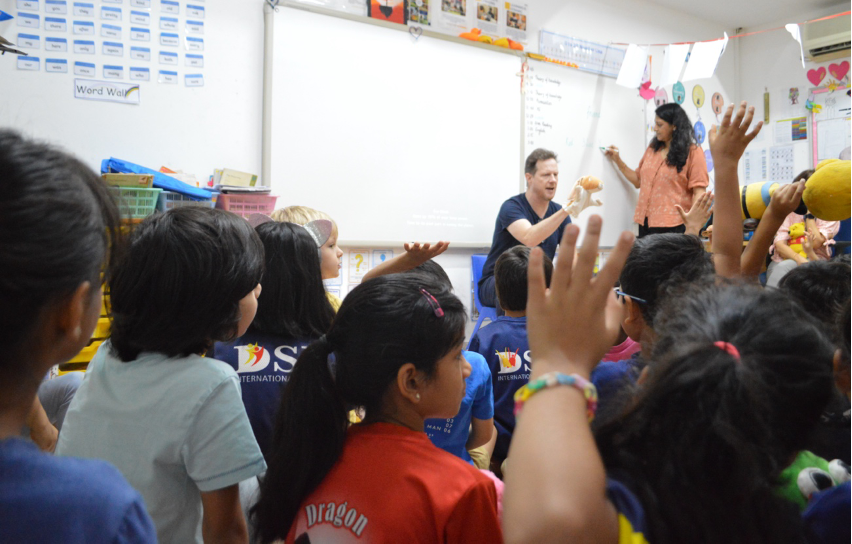Closing the Ouroboros Education Loop
DP1 TOK Exhibition + KG Judges = Albert Einstein in Action!
If Mary Poppins’ solution to creating forward momentum was to add a spoonful of sugar, then perhaps putting a cohort of stressed out teens in front of an audience of curious primary school students wasn’t the best idea I’ve ever had.
In terms of cognitive learning, however, the medicine went straight down.
Albert Einstein famously said, “if you can’t explain it to a six year old, you don’t understand it yourself.”
Here at DSB International School, we took him at his word. As Head of Core, I challenged our DP1 students to explore the complexity of their chosen Theory of Knowledge prompts in their exhibition by delivering their arguments to a far younger-than-usual audience.
Specifically, our kindergarten students at DSB’s Garden Campus in the heart of Mumbai!
All teachers understand that the mere pursuit of knowledge isn’t enough. Without student uptake, all efforts are in vain. The International Baccalaureate’s Theory of Knowledge (TOK) aims to foster critical thinking skills, encourage an appreciation for multiple perspectives, and deepen students' understanding of how knowledge is constructed and justified.
By engaging in rigorous inquiry and reflection, students develop a greater awareness of the underlying assumptions and biases that shape our understanding of the world.
The TOK exhibition is an essential part of this approach, giving students entering their final year of secondary education the opportunity to showcase innovative arguments and profound discoveries to their teachers and peers. The exhibition serves as a platform for these students to delve deeper within an area of inquiry, looking at the ways we acquire, evaluate, and apply knowledge in different areas of study.
The results of this can often be mixed.
Exhibitions can be exhilarating affairs for some students, and painful teeth pulling for others. That’s why this year we took a fresh approach, and embarked on this truly transformative experiment.
To ensure the success of this innovative approach of delivering philosophical arguments to five year olds, workshops and practice sessions were organised for both the DP1 students and their much younger counterparts. These sessions focused on refining the presentations, making them accessible and captivating for young minds, and questioning outcomes in truly innovative ways. Discussions centred around clear language, relatable examples, and compelling visual aids, all essential elements for simplifying complex ideas without diluting their essence.
Simultaneously, the young jury, composed of five and six-year-olds, were guided to understand that different perspectives exist, preparing them to grasp concepts such as symbolism and multiplicity of meaning.
On the day of the exhibition, the school garden transformed into an interactive learning zone. Each DP1 student crafted their own inviting ‘magic carpet’ as a gateway to active participation and engagement with the younger students. To ensure a seamless flow, the primary students were divided into small groups, and guided by their teachers through each exhibit. This arrangement ensured personalised interactions and a supportive environment that nurtured questions and discussions. The older students enthusiastically engaged with their younger peers, sparking curiosity and tailoring their explanations to suit their level of understanding, all the while maintaining the key philosophical points they were trying to deliver. The primary group that asked the most questions were rewarded with books on Indian mythology, an homage to the creators of duality of meaning.
The impact of this approach was extraordinary.
Giving the older students the challenge of distilling complex concepts into simple, relatable explanations deepened their own understanding of TOK topics, gaining increasingly profound insight through simplicity.
Meanwhile, the younger Garden Campus students were introduced to advanced subjects, expanding the boundaries of their existing knowledge. They posed insightful questions, and enthusiastically participated in interactive activities, demonstrating the transformative power of cross-grade collaboration.
Far from being a dry affair, the exhibition became a vibrant exchange of ways of knowing, bridging the age gap, and fostering a profound sense of community.
It showcased the transformative potential that arises from learning through diverse perspectives, and underscored the importance of effective communication in understanding complex ideas - a lesson that resonates deeply with all of us who are involved in education.
The Theory of Knowledge Exhibition at DSB remains an intellectually invigorating journey. Far from over simplifying the prompts, this year's break from tradition not only tested the older students' grasp of their TOK concepts, but also created a mutually beneficial vertical learning experience for both groups, challenging the boundaries of comprehension, captivating the minds of all, and leaving an indelible mark on the school community. Perhaps most importantly, however, it served as a reminder that, despite being separated by geography and age, both sets of students and teachers are all part of the same interconnected school community, united in our pursuit of knowledge and growth.
As Head of Core, I’m immensely proud of my DP1 Theory of Knowledge students rising to the occasion, and tackling something new and challenging so fearlessly and wholeheartedly.
As IB Coordinator, I’m excited by the possibilities that are open before us, and can’t wait to expand the program in new and innovative ways.
And perhaps most importantly, as an educator I’m simply humbled by the greatness inherent in our students across all ages.
This ouroboros loop in education, where the educators become students by teaching those at the other side of the pedagogical spectrum, is something that we sometimes struggle to fully grasp ourselves, no matter how long and extensive our training and experience.
At least, until we have to explain it to a six year old!





